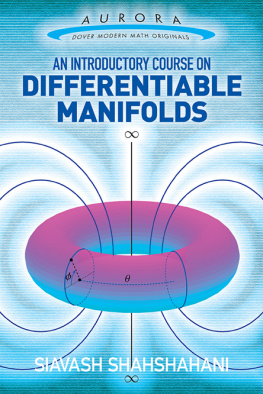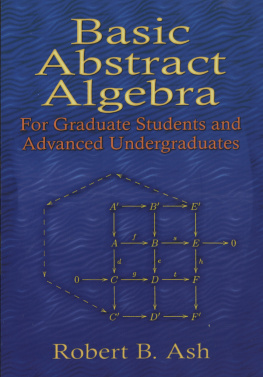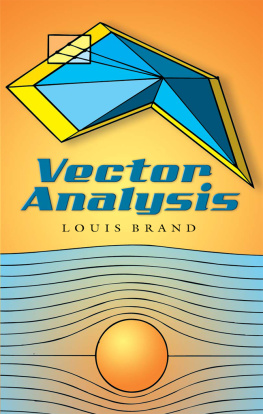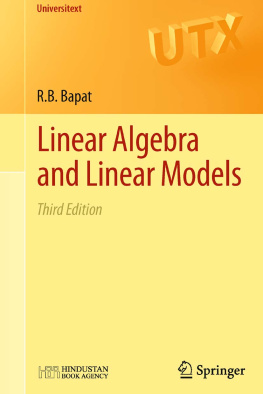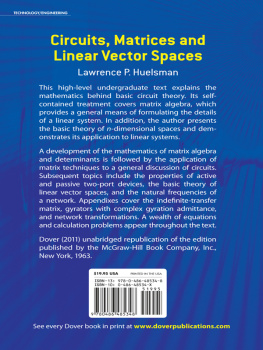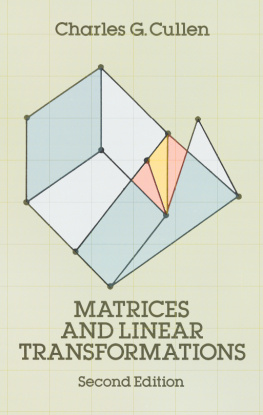Vector Spaces
and
Matrices
Vector Spaces
and Matrices
Robert M. Thrall
Professor and Chairman, Department of Mathematical Sciences
Rice University, Houston, Texas
and
Leonard Tornheim
Chevron Research Company
Dover Publications, Inc.
New York
Copyright 1957 by Robert M. Thrall and Leonard Tornheim.
All rights reserved.
This Dover edition, first published in 1970, is an unabridged and corrected republication of the work originally published by John Wiley and Sons, Inc., in 1957.
International Standard Book Number: 0-486-62667-9
Library of Congress Catalog Card Number 77-124180
Manufactured in the United States by Courier Corporation
62667901
www.doverpublications.com
Preface
The past several decades have witnessed a growing interest in the theory of vector spaces and matrices. One evidence of this interest is the replacement of the traditional course on theory of equations as the basic required course in algebra in many colleges by one on matrix theory. Aside from many uses in various parts of mathematics, matrices and vectors find use in circuit analysis (in electrical engineering), quantum mechanics, statistics, numerical analysis, econometrics, and operations research.
The wide range of applications of vectors spaces and matrices both inside and outside of pure mathematics has led to development of the subject at many different levels. Each higher level sheds new light and gives deeper insight into the basic facts. After having looked down from the heights the mathematician is sometimes tempted to feel impatient with lower level approaches. However, he must realize that the beginning student who is not yet equipped to climb to the heights needs to approach the subject at a level within his grasp.
At the lowest level everything is kept concrete. A matrix is regarded as an array of real (or complex) numbers, and the pages of a textbook written at this level are generously filled with summation signs applied to sequences of numbers. At a slightly higher level the matrices and vectors become the basic elements although one still must occasionally deal with the components. At this level vectors are defined as n-tuples, and more general types of vector spaces are not considered. At a still higher level vector spaces are defined axiomatically, and the theory is developed over an arbitrary (commutative) field, but without recourse to the theory of groups with operators. At the higher strata of this level matrices are replaced by linear transformations and bilinear functions; the theory proceeds without mention of n-tuples. At still higher levels the numerical scalars are replaced by elements of a ring and the theory of vector spaces becomes a corollary to general theorems about groups, rings, and algebras.
Each level carries with it many advantages and disadvantages. The lower levels do not give enough insight into the basic facts and the higher levels are too abstract for the beginner. In the present textbook we have chosen to proceed simultaneously at two levels, one concrete and one axiomatic. Thus in the first chapter we introduce n-tuples and abstract from them a set of axioms for a vector space. Each new property of a vector space is first discussed at one level and then at the other. Sometimes the concrete approach precedes and sometimes it follows the axiomatic one. We feel that this dual approach has many advantages. It introduces the student to the elegance and power of mathematical reasoning based on a set of axioms and helps bridge the gap that lies between the pre-eminence of problem solving found in most elementary undergraduate courses and the axiomatic approach that characterizes much modem research in mathematics. On the other hand, the frequent return to concrete formulations helps keep the students feet on solid ground. We have tried to develop understanding and conceptual grasp, rather than mere manipulation.
In the early chapters we have supplied a far more detailed exposition than is found in many textbooks. It has been our experience that this fullness in detail is extremely important for the student who is having his first experience with mathematical rigor. Only after he has won his spurs can he afford to replace the sometimes tedious details which clinch a proof by a phrase such as continuing in this fashion . Moreover, such statements frequently gloss over an induction argument, and we believe that an objective of this course should be to give the student a thorough grounding in proof by induction.
The book is designed for a one-year course meeting three times per week. We have found that in a one-semester course one can cover the first five chapters and some topics from the sixth and seventh chapters.
The first two chapters introduce the concepts of vector space, linear transformation, and matrix. The third chapter applies these concepts to the problem of solving systems of linear equations. Although these three chapters are closely knit, the instructor who wishes to will find it possible to rearrange the order of presentation so as to come to the solution of equations somewhat earlier. In particular can be omitted or postponed.
gives a self-contained development of the theory of determinants. The first four sections can be skipped if the students have already had an introduction to determinants.
is intended to introduce the student to the general concept of invariant and serves as a summary of what has preceded. It also includes a brief introduction to the theory of similarity.
present the usual material on bilinear and quadratic forms and on orthogonal equivalence.
The last four chapters are more advanced in nature, and the level of exposition is somewhat higher. The first part of presents the similarity theory with the usual canonical forms. It includes applications to geometry and to differential equations. Many further applications are considered in the exercises in this chapter.
The final chapter on linear inequalities presents a brief introduction to this important topic, which has until now been neglected in elementary texts on matrix theory. We hope that what we have given will provide the student with sufficient background so that he can read books and papers on game theory and linear programming.
We have chosen in this book to break off our treatment of group theory just short of a formal development of the concept of factor group. This decision was based on the conviction that, if we went as far as factor groups, it would be difficult to avoid raising the level of the entire book to such a point that it would have become a textbook on groups with operators with applications to matrix theory. However, in cases where more group theory is available or suitable we recommend that the instructor point out how some of our proofs can be simplified. This holds especially in the last four chapters.
We wish to acknowledge the help and suggestions of many friends who read and tested the manuscript in an early version. Included among these are E. A. Cameron, G. K. Kalisch, J. E. McLaughlin, C. J. Nesbitt, J. A. Nyswander, H. Raiffa, G. L. Thompson, and A. W. Tucker.
ROBERT M. THRALL
LEONARD TORNHEIM
March 1957
Contents
1.1. Introduction. In arithmetic and elementary algebra we study operations on numbers and on symbols which represent numbers. In plane geometry we describe each point by a pair of numbers and so can bring the tools of algebra to bear on geometry. In solid geometry a triple of numbers is employed, and for higher dimensions we merely use more numbers to describe each point and proceed algebraically much as in the two- and three-dimensional cases. Even though for dimensions greater than three we have no direct physical representation for the geometry, it is still useful to employ geometric language in describing the algebraic results.



